Analyzing the masterful offensive-line play of teams in NFL conference championships

The skill-position talent that will be on display during the NFL’s conference title games is, to put it lightly, worthy of such a stage. Four of the best quarterbacks in football, superstar wide receivers, playmaking tight ends, a handful of highlight-reel running backs ... it’s all there.
None of the teams still alive, though, would be where they are without their offensive lines. The Packers, Falcons, Steelers and Patriots’ lines all have areas in which they excel, and all will be leaned on this week.
So, what does each unit bring to the table? A quick team-by-team primer:
Dante Scarnecchia is back in Foxborough, and so is an effective, reliable Patriots O-line
Green Bay Packers
When we talk about an offensive line being “dominant,” that usually means in the run game—think Dallas and Ezekiel Elliott. The truly great O-lines are known for manhandling their opponents, wearing them down.
The Packers are unique because they accomplish the same thing with their passing attack.
That’s not to say they are incapable of running. In fact, with the Ty Montgomery-Aaron Ripkowski combo, the Packers can drum up a nice balance of inside and outside run success—usually from Montgomery on wide zone runs and Ripkowski between the tackles, but not always.
They reversed that formula for their two biggest runs vs. the Cowboys: a 15-yarder by Montgomery on which he followed a pulling Corey Linsley and Ripkowski into the guard/tackle gap for 15 yards (watch that play here), and a 21-yarder by Ripkowski with right guard T.J. Lang pulling all the way around the left side to clear LB Sean Lee.
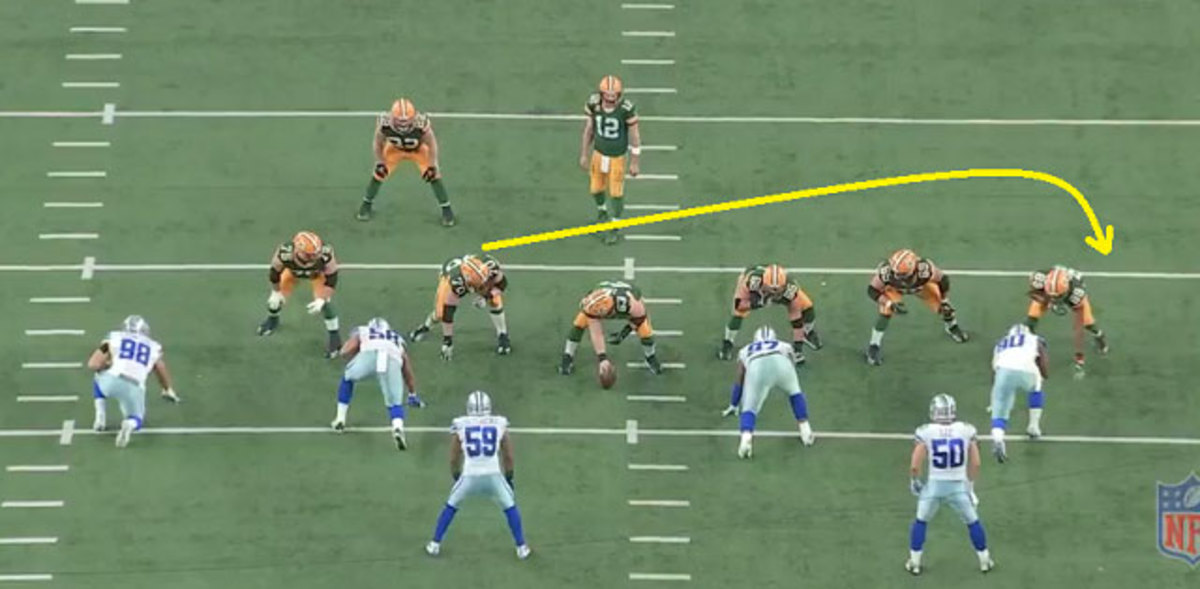
Also key to the Ripkowski run—and the Packers’ rushing attack as a whole—is the willingness of their receivers to block. Here, Geronimo Allison stepped up to knock safety J.J. Wilcox off his path, freeing up Ripkowski to get beyond the front lines.
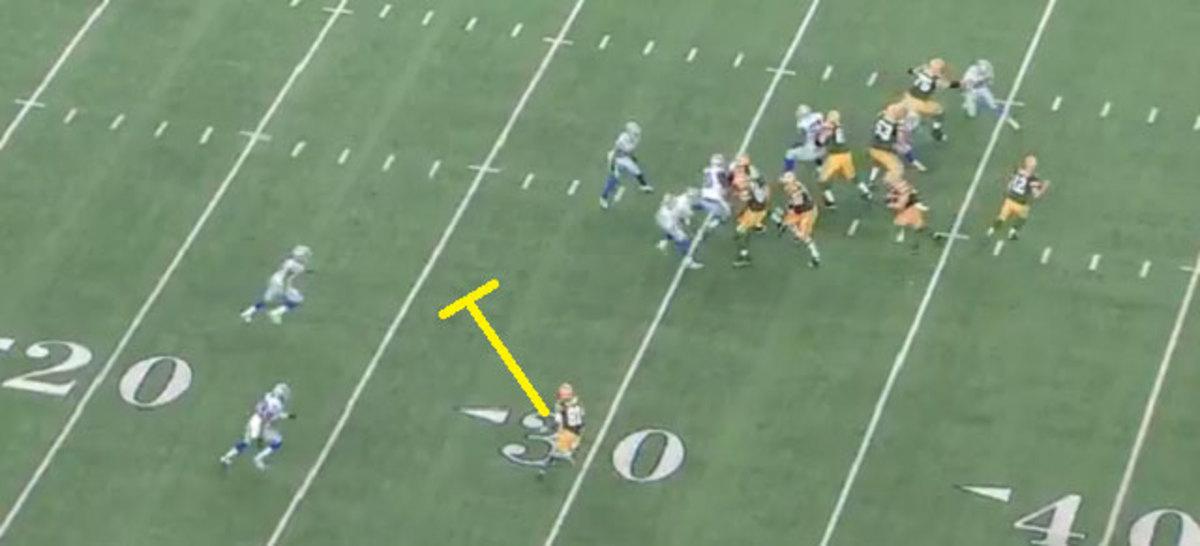
The Green Bay run scheme, which is relatively simple and straight-forward (though it requires athletic linemen), is usually good for two or three medium gains per game, with Montgomery capable of taking one the distance. Ex-NFL lineman Geoff Schwartz recently broke the Packers’ ground game down, in depth, for SBNation, if you’re itching for more.
That pass protection, though, is the Green Bay calling card. Rodgers will take sacks (five vs. Dallas, 32 during the regular season), but no offensive line in football has to block on extended plays the way the Packers’ line does when Rodgers gets to running around.
David Bakhtiari told SI after Green Bay’s Week 17 win in Detroit that the “coaches emphasize to block for infinity,” something Rodgers brought up this week: “I saw a comment this week about ’blocking to infinity’ —that that’s how their mindset is—[but] I try to keep it a little bit underneath that,” he said, via ESPN.com. “Those guys do a terrific job of giving me the time and allowing me to extend plays when the first, second and third option are not open. That’s what our offense has done for a number of years. This group does it as well as we’ve ever had it around here.”
Rodgers’s highlight-reel touchdown pass against the Giants saw him hold the ball for 8.3 seconds. It was nearly five seconds before the first defender came close to him, and Lang managed to move that body aside so Rodgers could step away from trouble.
The Rodgers-to-Jared Cook connection late last Sunday saw Rodgers hold the ball for almost six seconds, including a spin out of the pocket and a roll to his left. Take a look at where left guard Lane Taylor is as Rodgers begins to look for Cook.
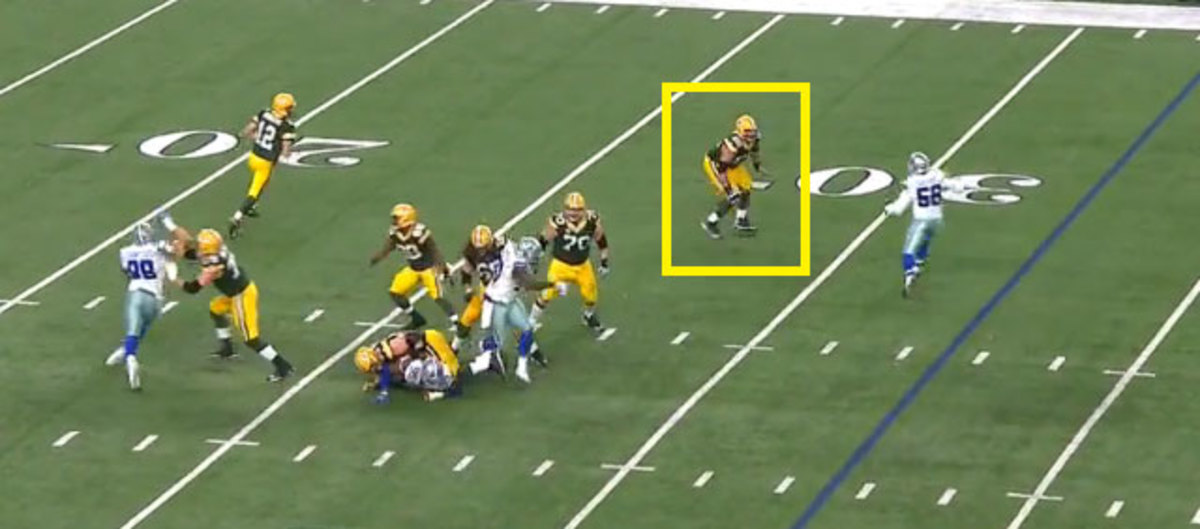
This happens time and again when Rodgers relocates himself from the pocket. It would be easy for those O-linemen to get caught up in the mix between the hash marks; it’d be even easier to release downfield, illegally, knowing how effective Rodgers is running the football. Instead, more often than not, freed-up offensive linemen stick with Rodgers for as long as it necessary.
If Taylor wasn’t there to shield off Dallas LB Justin Durant, Rodgers probably would have had to throw the ball away or might have taken a huge shot if he didn’t. But the Packers’ offensive line is proficient at holding the fort for as long its QB needs.
Atlanta Falcons
The outside-zone runs briefly mentioned above? Those are the bread-and-butter of Atlanta’s run game. It’s a big part of why Kyle Shanahan could be the next 49ers’ head coach, just as that scheme was integral for his dad, Mike Shanahan.
“He’s always had a great sense for how he mixes stuff and how he utilizes personnel, how he analyzes defense,” Seahawks coach Pete Carroll said of Shanahan before the Falcons’ playoff win last weekend, per SeattlePI.com. “He’s really an exceptional coordinator, and that scheme goes along with all the other great tools that they have.”
There can be no hesitation on wide zone plays. This isn’t like the Pittsburgh rushing approach, where Le’Veon Bell takes a handoff and jitterbugs in the backfield before finding a hole. When Devonta Freeman or Tevin Coleman get the ball from QB Matt Ryan, they are sprinting hard to their right or left, then cutting hard upfield as soon as they find a hole.
So, the offensive linemen have to be on their horses, too.
Take this 15-yard run by Coleman during the Falcons’ divisional-round victory. He starts the play lined up on the left hash mark, behind Ryan (left). When Coleman finally makes puts his foot in the ground to turn toward the end zone, he’s nearly at the far right numbers.
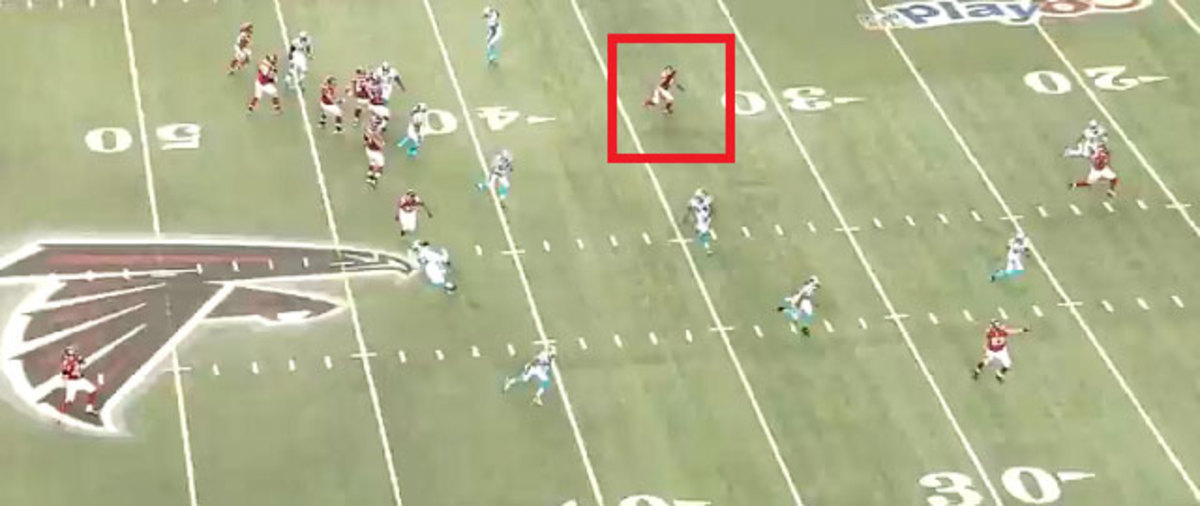
In order to find that open real estate, Freeman needed center Alex Mack and right tackle Ryan Schraeder to stick with Jarran Reed and Frank Clark, respectively, as they slid down the line. He also had to have a block from right guard Chris Chester, who raced up to the second level to put a hat on linebacker Bobby Wagner.
Freeman, especially, makes the zone runs dangerous because he doesn’t necessarily stay in the initial hole. He’ll cut back against the grain, if there’s room.
“Your block might really matter on the backside,” said Mack, one of the most important pickups made by any team last off-season. “Having a guy that breaks tackles, and you see that and witness that on the field enough time, you’re really going to try to block for a really long time because you never know where the ball’s going to go.”
Atlanta Rising: The Falcons and their fan base embark on a new era
The Falcons do not use a ton of play-actions and bootlegs off the wide-zone action—they tried far more of that last season, and it was an uncomfortable fit with Ryan, a lethal pocket passer. Most of the Falcons’ passes come on straight dropbacks, often with empty backfields.
When Shanahan does call those misdirections, though, they can be lethal. Austin Hooper’s first career NFL touchdown came back in Week 4 on just such a play. The Falcons faked a run left out of a heavy set, rolled Ryan back to his right and then released Hooper into an opening downfield for an easy pitch-and-catch deep ball.
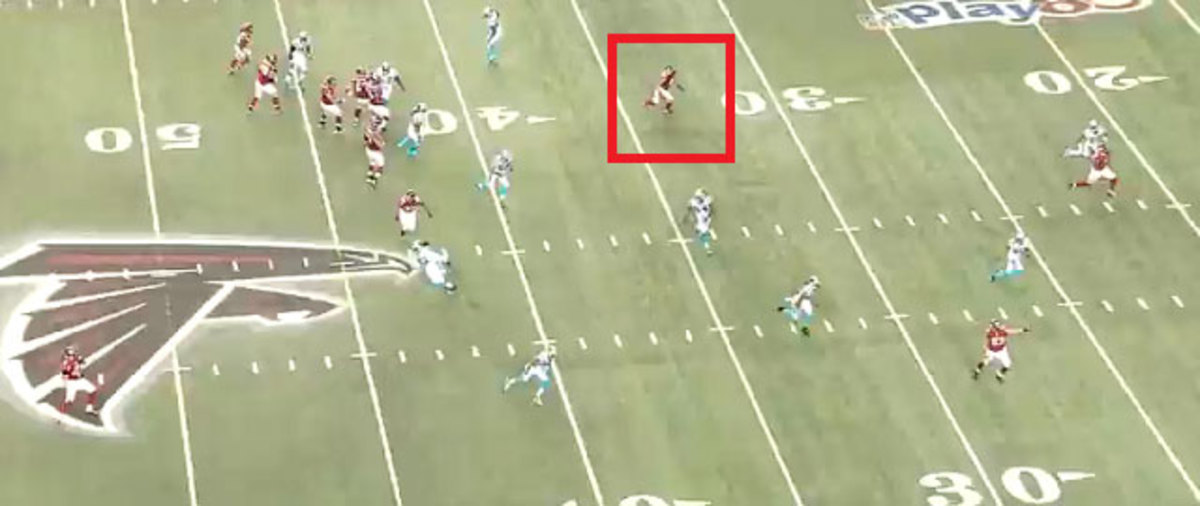
Another favorite that’s only open because of what the run game opens up? A quick little pop pass, like one that gained 16 yards vs. the Chiefs. Ryan likely has a run-pass option on these, and can throw away from the zone run if he sees a certain look.
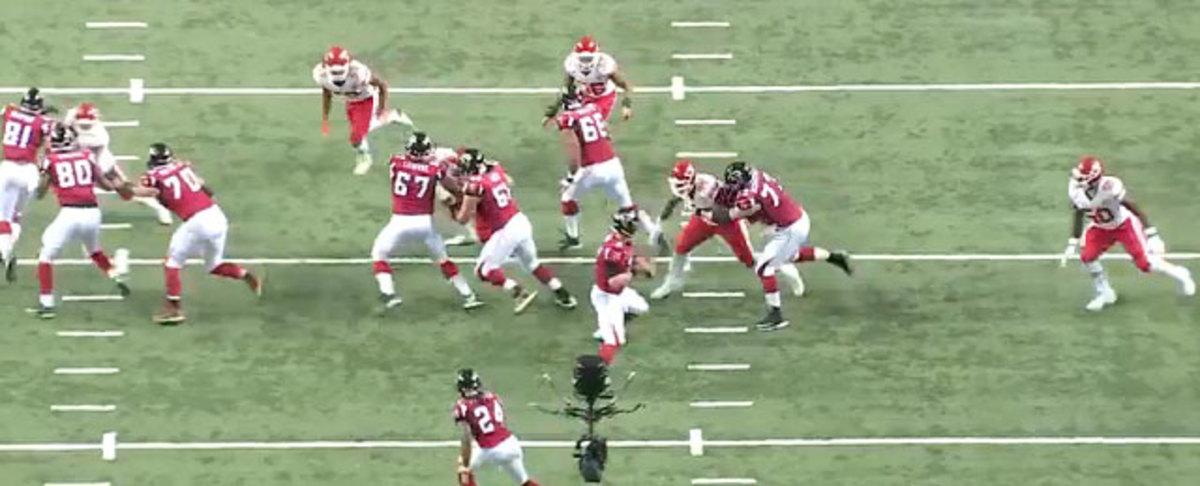
The pop pass is a college football staple, mainly because there’s more leeway for linemen to release downfield, but Atlanta has put it to use by drawing attention with their wide blocking.
The Falcons’ offense is a nightmare for opposing defenses because of how many ways it can create mismatches. It’s blocking scheme up front, and the way the Mack-led O-line executes it, helps set the table for an awful lot.
Pittsburgh Steelers
Several facets of Pittsburgh’s O-line success were covered in the Packers’ and Falcons’ sections. The Steelers use a lot of zone-run looks, especially of the inside variety, to take advantage of Le’Veon Bell’s skill set. QB Ben Roethlisberger will be given several run-pass option plays per game, and he utilized the pop pass multiple times with TE Jesse James just last week.
And the Steelers’ linemen have to be willing to dig in and hold their ground. Bell’s patience in the backfield earns him praise, deservedly, but he wouldn’t be able to take his sweet time if the big bodies up front were less effective.
“It’s the line,” said Roethlisberger, after his team’s win at Kansas City last weekend. “Le’Veon is awesome, there’s no doubt about it, but we are only as good as the group up front. They do a lot of the dirty, grimy work. Against that pass rush, that defense, in a hostile and loud environment, you have to tip your cap to the guys up front.”
It goes without saying that the Steelers prefer to push their linemen to the second level in front of Bell. They’re also fine if Bell winds up in a gap one-on-one vs. a linebacker. To wit:
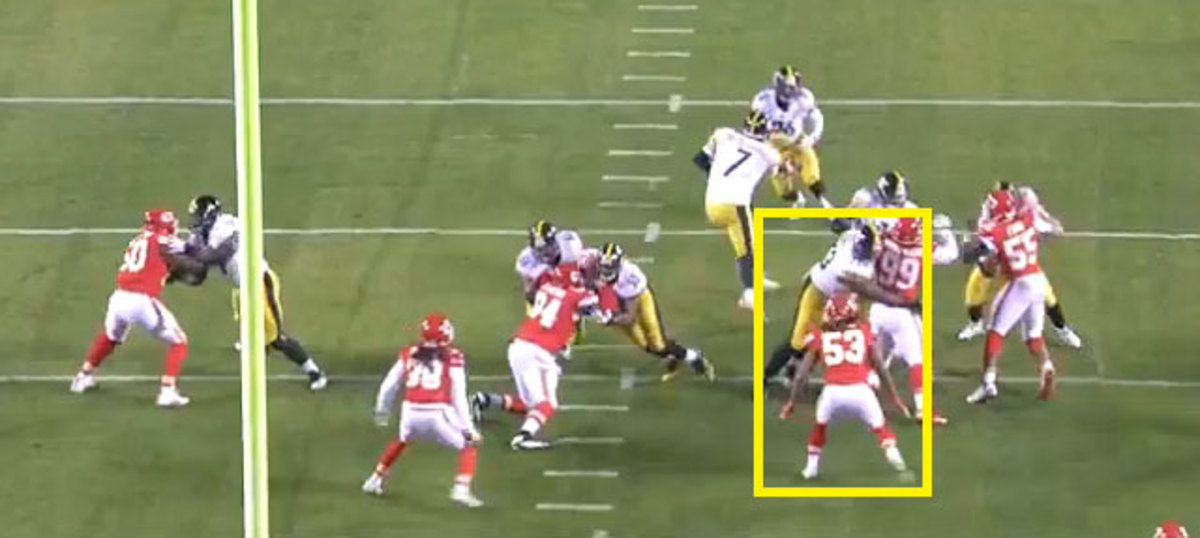
James served as an inline blocker there, giving the Steelers’ six up front against the Chiefs’ four. The double teams on Jarvis Jenkins (No. 94) and Rakeem Nunez-Roches (99) afforded the Steelers an edge at the point of attack, but it also set them up to release linemen into the Chiefs’ linebacking corps. On that above shot, one can already see left guard Ramon Foster kicking off his initial double-team block onto linebacker Ramik Wilson.
Because of how dangerous they are through the air, the Steelers also are are a threat on draw plays. The line is very effective both at allowing defensive linemen to pursue upfield or pausing a beat before pushing forward. In either case, Bell tends to find the hole he needs to pick up positive yards.
After The Helmet Catch, David Tyree took a winding road to his second Giants job
However, where Pittsburgh may be at its best is when it puts a lineman on the move. The ability to pull was mentioned as a positive for the Packers, and it’s certainly a plus in Mack’s game for the Falcons. And all of the Steelers’ interior linemen—Foster and David DeCastro as the starting guards, Maurkice Pouncey at center—are outstanding when as pulling lead blockers. Even backup B.J. Finney had a terrific pull block to spark a big gain during a regular-season win at Buffalo.
The Steelers will ask any of their linemen to go on the move, at any time.
A 17-yard run by Bell in last Sunday’s win at Kansas City featured a strong blocks by DeCastro and right tackle Marcus Gilbert, but the real showstopper came from Pouncey’s pull into the right/guard tackle gap to lead Bell.
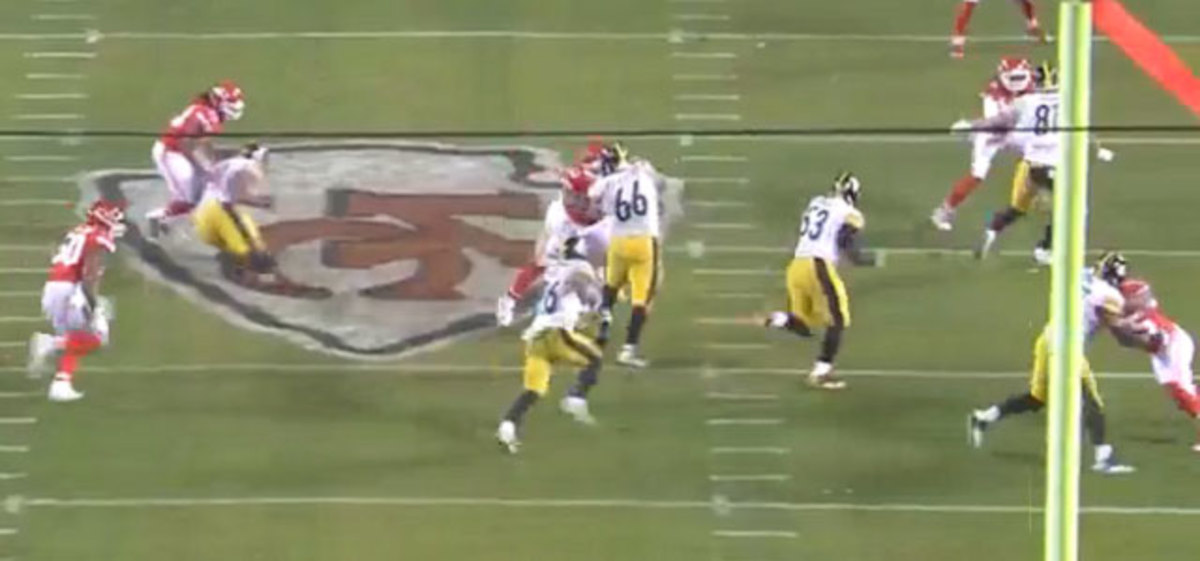
Here’s another one: This time the Steelers swung left tackle Alejandro Villanueva over to clear safety/linebacker Daniel Sorensen, thus leaving Justin Houston unblocked with the trust that Bell would be quick enough to avoid him. (He was.)
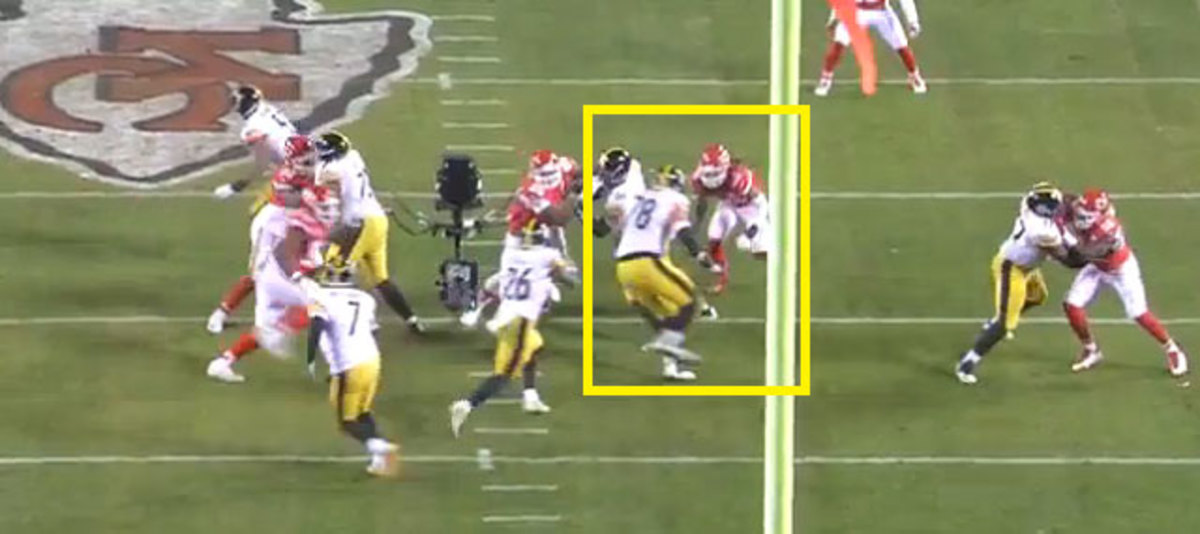
This is a really solid offensive line. When the Steelers want Bell to run between the tackles, there is enough power up front to move a defensive line back. When they want to get a little wider, everyone along that O-line has the nimbleness to lead the way.
New England Patriots
SI’s Greg Bedard took an in-depth look this week at arguably the most important piece to the Patriots’ O-line puzzle: assistant coach Dante Scarnecchia. His return has made a noticeable difference up front, where the Patriots have rolled with youth—starting guard Joe Thuney is a rookie; fellow starting guard Shaq Mason and starting center David Andrews are in their second seasons.
Also important for New England has been the line’s continuity. This is a major selling point for Atlanta, too—every member of the Falcons’ starting five linemen has played at least 94% of the team’s snaps. For the Patriots, according to Football Outsiders, the number is 90.9%. It’s been Nate Solder, Thuney, Andrews, Mason and Marcus Cannon for a vast majority of the season.
“Well, it’s been a real blessing for our team,” Patriots QB Tom Brady said last week, when asked about the line staying healthy. “Because you’re right, last year was so challenging. Guys were in and out. We had some big, kind of catastrophic injuries with guys being out all season ... This year we’ve had a lot of stability, which is great for any offensive line, and it’s really been a big part of the reason why I think our offensive line has played so well.”
Brotherhood of Brady: The lifelong connection between the QB and his receivers
Truth be told, the Patriots line can be considered a potential Achilles’ heel. That group was clobbered by Denver in last season’s AFC championship game (before Scarnecchia came back from ”retirement”); the Texans caused problems in the divisional round by moving their pass rushers inside, forcing the Thuney-Andrews-Mason trio to account for the likes of Whitney Mercilus and Jadeveon Clowney.
And while it’s true that New England finished with the third-most rushing yards in the league this season, it took the third-most rushing attempts to get there. The Patriots averaged 3.9 yards per carry (25th-best).
Regardless, the line has been solid enough for New England to establish its offensive balance. The blocking scheme the Patriots utilize is a diverse one, meant to take advantage both of bruising back LeGarrette Blount and the quicker Dion Lewis.
The Patriots can create advantages, as well, by using TE Martellus Bennett and FB James Develin—both among the best blockers in the league at their respective positions. On a 14-yard Lewis run vs. Denver, Develin (on Corey Nelson) and Bennett (on Von Miller) delivered two strong blocks to help create a huge hole.
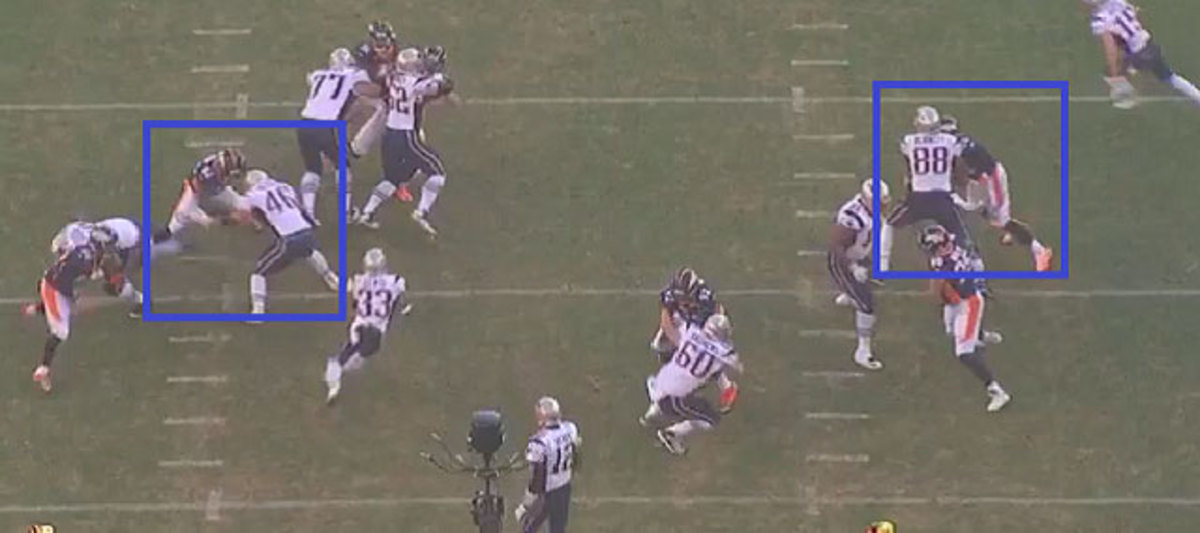
Bennett on Miller isn’t a matchup the Patriots would want on passing downs, but it can work against the run. Keep that in mind Sunday, if Bennett lines up across from James Harrison or Bud Dupree.
That Lewis run in Denver also featured a variation on one of New England’s favorite, most effective blocking ploys: the wham. The basic idea of a wham block is that the O-line bypasses a defender, then a fullback/H-back/tight end swoops in to trap that defender as he begins to push upfield. (Ex-NFLer Matt Bowen with more on the wham here, if you’re interested.)
The Patriots use this approach quite a bit, using Develin or their tight ends (usually Rob Gronkowski, when he was healthy) to clean up the backfield so an offensive lineman can get to the second level.
An example from the Patriots’ earlier win over the Steelers:
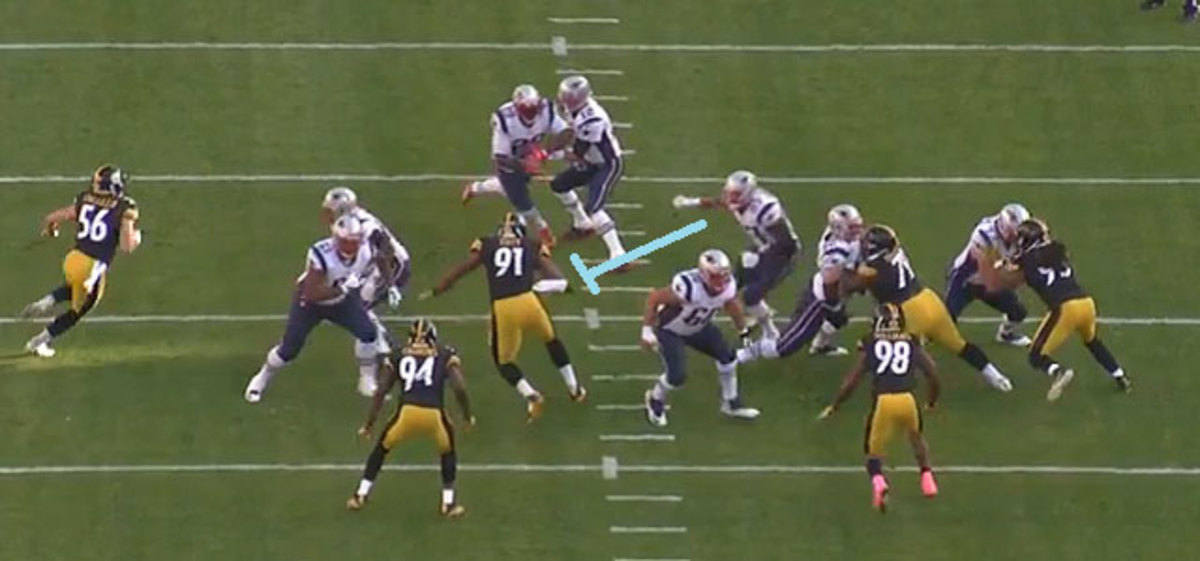
You’ll notice that the Steelers’ Stephon Tuitt (No. 91) had no one between himself and Blount when Blount takes the hand-off. Coming over to move Tuitt, though, was Gronkowski, and behind that block Blount would pick up nine yards.
Pass protection for the Patriots usually boils down to holding the fort. Brady is among the quickest draws in the league—against Miami in Week 17, per WEEI.com, he needed just 1.85 seconds per throw. That’s a microscopic number.
One thing opposing defenses have to be aware of, though, is the Patriots’ screen game. Because of their athletic linemen, pass-catching backs and receivers with a willigness to block downfield, the Patriots can sneak Blount, Lewis or James White out of the backfield with surgical effectiveness. They hit the Steelers with one such screen for a White TD back in Week 7. (Video here.)
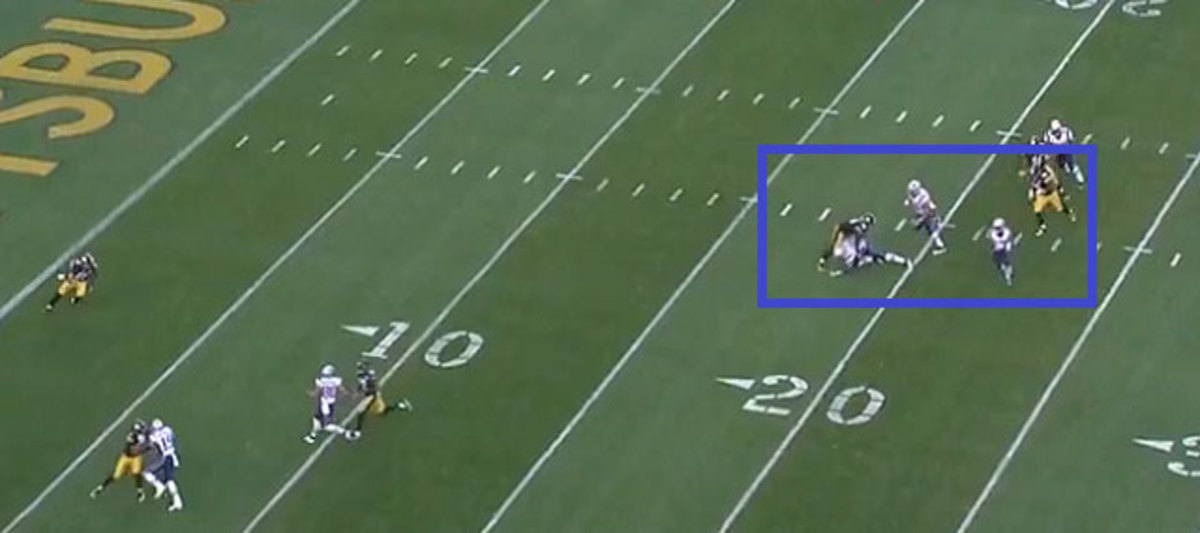
Thuney and Andrews released as the blocking caravan, with Andrews clearing a defender a good 15 yards downfield so White could waltz into the end zone.
The Patriots do not have one of the league’s great lines. It’s even a unit that can be exposed, on occasion, by a decent pass rush. But what that line and blocking scheme can do is force a defense to be aware of a laundry list of possibilities. Brady & Co., can strike in more different ways than perhaps any other offense in the NFL.
